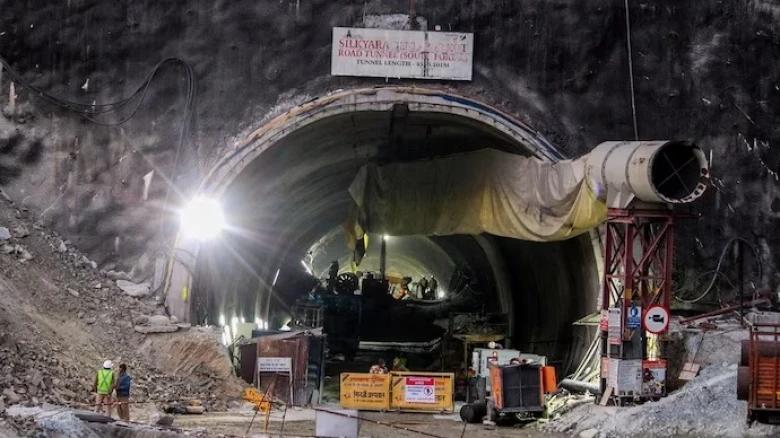According to authorities, supplies are being sent to the workers trapped below 60 metres of debris via pipes, and they are in continuous contact with them.
Digital Desk: On Saturday morning, efforts to rescue the 41 workers who were stranded in the Uttarkashi tunnel under construction began again. Drilling has now started after being stopped at about 2:45 pm on Friday due to a loud cracking noise heard in the tunnel.
The captive individuals' coworkers voiced their displeasure with the operation. They asserted that the present predicament is the direct result of the corporation and its general manager.
According to authorities, supplies are being sent to the workers trapped below 60 metres of debris via pipes, and they are in continuous contact with them.
Only 24 metres of debris have been removed from the collapsed tunnel by rescue crews thus far.
Similar to the 25-ton American-made machine currently in use, backup equipment for the rescue mission was also being brought in from Indore amid concerns of technical problems with the American auger machine.
Alongside the horizontal drilling that has been ongoing for the past week, vertical drilling activity started on Saturday, according to Bhaskar Khulbe, a former counsellor in the Prime Minister's Office.
• Coworkers of those trapped in the rescue operation expressed their dissatisfaction with the operation as it approached its seventh day. They asserted that the current issue is the direct result of the corporation and its general manager. The agitators emphasise that they cannot survive on water and grammes and suggest tunnelling through to their stranded colleagues.
• On Friday afternoon, rescue operations at the Uttarkashi tunnel, where 41 workers are stranded, temporarily stopped. This happened when, as the fifth tube was being inserted into the tunnel, debris started to fall again towards the drilling machine. Operations were halted for about an hour while rescue personnel within the tunnel were promptly evacuated as a precaution.
• On Friday, there were rumours that the American auger drilling equipment had a technical malfunction that was negatively impacting rescue operations. The building business refuted it, though. According to Pakistani news agency PTI, an official construction business responded to claims that equipment resembling the American-made machine was being flown in, stating that it was only a "backup".
• As the machine drills through the wreckage, the rescue plan calls for inserting six-meter pieces of steel pipes, each with a diameter of 800 or 900 mm, one after the other. A specialised crew is currently investigating the feasibility of vertical drilling by looking into the upper portion of the tube. Contingency plans call for trying to reach the workers by drilling from the top of the mountain if the horizontal drilling in front of the tunnel proves to be ineffective.
• Khalkho said that the process periodically pauses because of things like vibrations created in the tunnel while drilling and smells produced by the diesel-driven equipment in small areas. According to PTI, he informed reporters that the equipment is operating adequately and that he expects it to speed up as rescue personnel become more acclimated to the procedure. About 22 tonnes of vital equipment were flown from Indore to Dehradun on Friday by an Indian Air Force C-17 plane as part of the continuing rescue efforts at the Silkyara tunnel site in Uttarakhand.
• Visitors to the rescue site have included relatives of the workers trapped in the tunnel as well as officials from their home states. Through a conduit that runs through the debris, they are allowed to speak with the people who are trapped. But after the tunnel collapsed, one of the workers' families said they had not been able to get in touch with Sonu Shah, a Bihar resident.
• According to the State Emergency Operation Centre, 165 workers from a variety of agencies, including the Indo-Tibetan Border Police, State Disaster Response Force, National Disaster Response Force, and Border Roads Organisation, are working around the clock to rescue people.








Leave A Comment